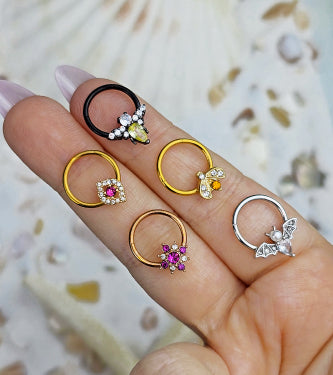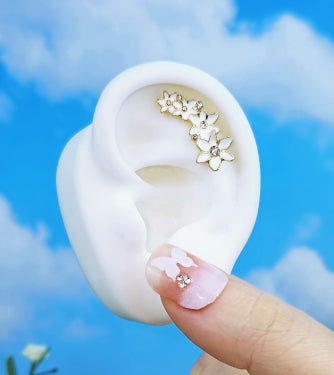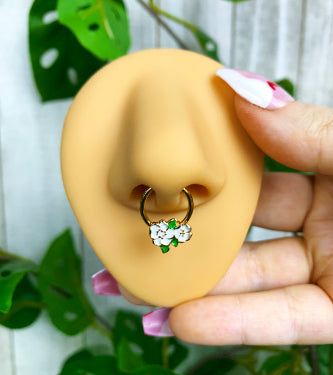Piercings, as much as we love them, come with risks. That is just a simple fact. We’ve all seen social media posts of what can go wrong with a piercing. Some of these things are fairly minor and can be dealt with at home but some are pretty major emergencies which, while rare, can still happen. We’re not trying to talk you out of getting the piercing of your dreams, but today we’re going to take a moment to review some of the risks that go along with getting pierced.
Bleeding
This seems quite obvious. A person is putting a needle through your flesh, naturally it is going to bleed to some extent. However, an inexperienced piercer who is working on a particularly vascular area (such as tongue or cheek piercings) has the potential to hit a major blood vessel. This is why it’s really important that you go to a trustworthy piercer. Even a septum or helix piercing that goes exactly as it should, can bleed a lot. You should be prepared for that possibility.

Swelling
Swelling for a new piercing can range from barely noticeable to extremely noticeable. Oral piercings are notorious for swelling. If you are planning to pierce your tongue, philtrum, or lip, you should be prepared to deal with swelling that may prevent you from eating or speaking normally for several days. Cheek piercings are also notorious for a cycle of swelling and normalizing and then swelling again for the entire healing process, which creates a need for numerous jewelry changes. You should be prepared to deal with that, and pay for that, on a regular basis.
Bruising
Piercings will frequently bruise after they are initially performed. What people may not tell you beforehand is that piercings that are near the eyes (eyebrow, nasal bridge, anti-eyebrow) can leave you with a black eye or two. This is normal but can be a bit unsightly. If you are planning on going to an event where there will be lots of pictures taken, maybe get the eyebrow piercing afterwards and not before.
Scarring
All piercings scar, it’s just a matter of degree. A healthy piercing that is simply retired will still leave some level of scarring behind. A piercing that is in rough shape when it is removed will leave worse scarring than a healthy one. And all piercings have the potential to develop keloid scarring, a large fleshy scar tissue that requires removal by a plastic surgeon if you wish to remove it. You can treat non-keloid scarring at home with topical products and making sure to use sunscreen but while you can reduce the visibility of the scar it will still be there.
Migration & Rejection
This is where things have gone really wrong for your piercing. Migration is when your body has pushed the jewelry out of its proper position. If your tragus piercing is three millimeters aways from where it pierced, it has migrated. Rejection is when your body has begun to push the piercing entirely out of your body. If you can see a lot more of the barbell part of your belly ring, if the skin seems to be pulling away from the jewelry, or if you can actually see the jewelry through your skin, your piercing is rejecting. Rejection requires that you remove the jewelry and let the piercing heal. Migration requires getting checked by a quality piercer who will then probably still remove the jewelry to prevent further migration and a nastier scar. The longer you let either process go on, the worse the scar will be. These both can be triggered by a number of factors including trauma (something hit your piercing), an improperly performed piercing, or the natural process of your body pushing out a foreign object. This is why dermal implants are considered “long term temporary” piercings, because eventually your body will push it out.

Infection
This is the worst-case scenario. If your piercing is red, hot, swollen, and oozing opaque yellow or green liquid and if you are possibly running a fever, you have an infection. There’s nothing your piercer can do to help you and neither can social media. You need medical attention. Do not remove the jewelry as that can trap the infection in your skin. Go to a doctor and get treated. This is especially vital if the piercing is near your eyes or mouth, but any infected piercing should be seen by a doctor.
We love piercings, you love piercings, and there is a lot to love about them. That said, you are paying someone to wound your body and put a foreign object in it. This will never be entirely without risk. It’s best that you know the risks as well as the rewards so that you can make informed decisions and also handle any issues that arise after the procedure. Get pierced joyfully, get pierced safely. Happy piercing!






